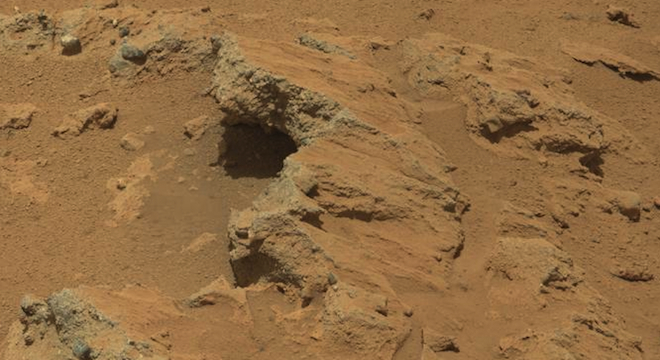NASA’s Mars Curiosity Rover has hit paydirt, discovering rock formations on the Red Planet that were most likely formed by the vigorous flow of a stream of water in Mars’ ancient history, NASA announced Thursday.
“There’s consensus that this is a rock formed in the presence of water,” said Mars Curiosity project scientist John Grotzinger of NASA’s Jet Propulsion Laboratory in a press conference livestreamed from JPL headquarters in Pasadena, California on Thursday.
Curiosity stumbled across the rock formations, which NASA dubbed “Link” and
“Hottah,” respectively, on September 2 and 14, while driving from its landing site in the 96-mile-wide depression known as Gale Crater to another site within the crater called “Glenelg,” where NASA hopes to begin collecting and studying the first samples of wind-blown sand.
But NASA had to study imagery of the “Link” and “Hottah” rocks captured by the rover’s 100-millimeter Mast Camera, or Mastcam, and double-check to make sure it was actually formed by running water before making the formal announcement on Thursday. The water was thought to be rushing at a speed 3 feet per second and at depth that would go up to a human ankle to hip.
Here’s the Curiosity Mastcam photo of the “Link” rock formation, which shows an abundance of water-deposited gravel:

And here’s another image from the Curiosity 100-millimeter Mastcam of the “Hottah,” formation, named for the Hottah Lake in Canada’s Northwest Territories:

Here’s a close-up of the “Hottah” formation showing a piece of rock rounded by the flow of water:

Both rocks contain tiny bits of rounded gravel a few inches in size in and around them, a formation in geology called a “sedimentary conglomerate,” or when rushing water brings smaller rocks smashing into each other and larger formations, cementing them together.
In the case of these particular rock formations, NASA believes that the water that helped form them actually came from quite far away, outside the rim of Gale Crater itself, then poured down in many different river channels into the area where the rover captured the images and even spread out toward its landing site. The water channels are thought to have carried the gravely materially that made up the rock formations, a phenomena that’s seen in many canyon-dotted and mountainous regions o n Earth, where its known as an “alluvial fan.”
Here’s a view of the alluvial fan that is said to be responsible for these rock formations, seen from space:

“This fan did not form in a single instant,” said NASA Curiosity science co-investigator William Dietrich, a professor at the University of California, Berkeley. “There was some duration of a process.”
Indeed, NASA believes that the sheer number of channels — scores of their tracks are visible in pictures taken from space by NASA’s Mars imaging satellites, the Mars Reconnaissance Orbiter and the Odyssey orbiter — indicates that the flow of water in this area was a sustained and long-lasting phenomena, though the agency declined to put a set date or time period on when or for how long.
Here’s a NASA computer-generated illustration of where the channels flowed, marked in blue, with the location of the Mars Curiosity Rover’s landing site marked by a black “x.”

Here’s another illustration from the view of the Rover, again denoted with a black “X,” looking toward the source of the channels, which would’ve flowed toward it:

Scientists think one specific river channel was the one that formed the types of rocks found in this area by Curiosity, a channel they’ve named “Peace Vallis.”
NASA’s Grotzinger was careful to note that although the finding was hugely significant in terms of fulfilling Curiosity’s mission objective to ascertain the habitability of Mars — whether or not it was ever capable of supporting life — there wasn’t yet any evidence to indicate whether or not anything ever lived in or off of the water that formed these rocks.
Grotzinger said that there were three major indicators NASA was hoping to see with Curisoity and other, later missions to determine the habitability of Mars: Evidence of water, sources of energy for microorganisms and sources of carbon. The new imagery provides definitive evidence of water, but the jury is still out on the other two indicators.
Curiosity’s team may decide to sample some of these rocks for evidence of carbon, using some of Curiosity’s 10 scientific instruments, which are capable of chemical and mineral analysis, but the NASA scientists are also keeping their eyes on the major prize: Mount Sharp, a 3.4-mile high mountain rising up from the floor of Gale Crater which NASA intends to drive the rover toward and scale partially.
And even if NASA finds evidence of organic carbon, that’s not necessarily evidence that life existed on the Red Planet.
“That in its own right does not require living microorganisms,” Grotzinger said, when asked by TPM, “Those types of arguments are based on preponderance of evidence and require multiple lines of evidence…That’s going to take other missions,” outside of Curiosity to determine, Grotzinger explained.
Still, the news of the water-formed rocks is big not just for the Curiosity team, but the study of Mars and planetary science in general.
“Plenty of papers have been written about channels on Mars with many different hypotheses about the flows in them,” Dietrich said in a NASA press release. “This is the first time we’re actually seeing water-transported gravel on Mars. This is a transition from speculation about the size of streambed material to direct observation of it.”






